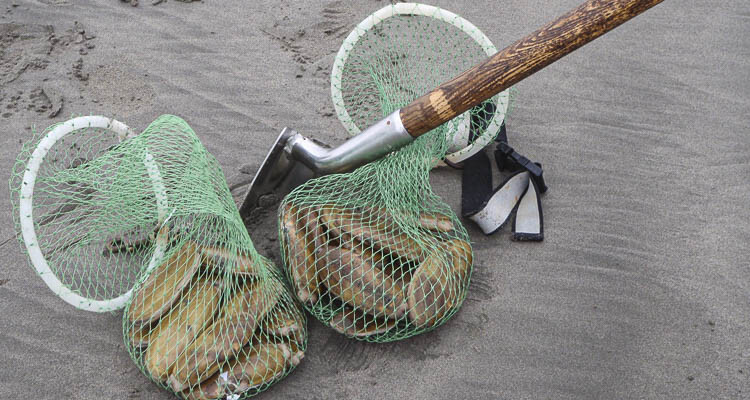
Additional digs planned for January and February
OLYMPIA – Razor clam diggers can look forward to more digging on coastal beaches beginning Jan. 9, Washington Department of Fish and Wildlife (WDFW) coastal shellfish managers confirmed today (Jan. 4).
“There was high surf during the last tide series of 2023, resulting in some difficult digging at times,” said Bryce Blumenthal, a WDFW coastal shellfish biologist. “Hopefully the start of 2024 brings better conditions and easier razor clam digging.”
Not all coastal beaches are open for every dig, so diggers are encouraged to make sure their intended destination is open before heading out. Optimal digging occurs between one and two hours before the listed time of low tide.
The following digs during afternoon and evening low tides (noon to midnight only) will proceed as scheduled, after marine toxin results from the Washington State Department of Health (DOH) showed razor clams are safe to eat:
- Jan. 9, Tuesday, 5:02 p.m.; -0.7 feet; Long Beach, Copalis
- Jan. 10, Wednesday, 5:46 p.m.; -1.2 feet; Long Beach, Twin Harbors, Mocrocks
- Jan. 11, Thursday, 6:28 p.m.; -1.5 feet; Long Beach, Twin Harbors, Mocrocks
- Jan. 12, Friday, 7:11 p.m.; -1.6 feet; Long Beach, Twin Harbors, Copalis
- Jan. 13, Saturday, 7:53 p.m.; -1.3 feet; Long Beach, Twin Harbors, Copalis
- Jan. 14, Sunday, 8:36 p.m.; -0.8 feet; Long Beach, Twin Harbors, Mocrocks
- Jan. 15, Monday, 9:19 p.m.; 0.0 feet; Mocrocks
The DOH requires test samples for marine toxins, and domoic acid levels must fall under the guideline level before a beach can open for digging. Domoic acid, a natural toxin produced by certain types of marine algae, can be harmful or fatal if consumed in sufficient quantities. Final approval usually occurs about a week or less – sometimes two to three days – before the start of each digging series. More information about domoic acid, as well as current levels at ocean beaches, can be found on the WDFW’s domoic acid webpage.
Additional tentative dates in January and February:
- Jan. 22, Monday, 4:28 p.m.; -0.1 feet; Mocrocks
- Jan. 23, Tuesday, 5:13 p.m.; -0.3 feet; Long Beach, Twin Harbors, Mocrocks
- Jan. 24, Wednesday, 5:53 p.m.; -0.4 feet; Long Beach, Twin Harbors, Copalis
- Jan. 25, Thursday, 6:28 p.m.; -0.4 feet; Long Beach, Twin Harbors, Copalis
- Jan. 26, Friday, 7:01 p.m.; -0.2 feet; Long Beach, Twin Harbors, Mocrocks
- Jan. 27, Saturday, 7:32 p.m.; 0.0 feet; Long Beach, Mocrocks
- Jan. 28, Sunday, 8:02 p.m.; 0.4 feet; Copalis
- Feb. 6, Tuesday, 3:52 p.m.; 0.0 feet; Mocrocks
- Feb. 7, Wednesday, 4:41 p.m.; -0.7 feet; Long Beach, Twin Harbors, Copalis
- Feb. 8, Thursday, 5:26 p.m.; -1.2 feet; Long Beach, Twin Harbors, Copalis
- Feb. 9, Friday, 6:09 p.m.; -1.4 feet; Long Beach, Twin Harbors, Mocrocks
- Feb. 10, Saturday, 6:49 p.m.; -1.4 feet; Long Beach, Twin Harbors, Mocrocks
- Feb. 11, Sunday, 7:29 p.m.; -1.0 feet; Long Beach, Twin Harbors, Copalis
- Feb. 12, Monday, 8:08 p.m.; -0.3 feet; Long Beach, Copalis
- Feb. 21, Wednesday, 4:56 p.m.; 0.2 feet; Long Beach, Twin Harbors, Mocrocks
- Feb. 22, Thursday, 5:33 p.m.; 0.1 feet; Long Beach, Twin Harbors, Mocrocks
- Feb. 23, Friday, 6:05 p.m.; 0.1 feet; Long Beach, Twin Harbors, Copalis
- Feb. 24, Saturday, 6:34 p.m.; 0.2 feet; Long Beach, Twin Harbors, Copalis
- Feb. 25, Sunday, 7:02 p.m.; 0.4 feet; Long Beach, Mocrocks
WDFW is accepting public comments on the alternative digging schedule change at Copalis and Mocrocks beaches during January and February. The public may email their feedback to razorclams@dfw.wa.gov.
On all open beaches, the daily limit is 15 clams per person. Each digger’s clams must be kept in a separate container, and all diggers must keep the first 15 clams they dig, regardless of size or condition, to prevent waste.
All diggers 15 or older must have an applicable fishing license to harvest razor clams on any beach. Licenses can be purchased from WDFW’s licensing website, and from hundreds of license vendors around the state. WDFW recommends buying your license before visiting coastal beach communities. Additional razor clam information is available on the WDFW razor clam webpage.
The Washington Department of Fish and Wildlife works to preserve, protect, and perpetuate fish, wildlife and ecosystems while providing sustainable fish and wildlife recreational and commercial opportunities.
Also read:
- Volcanoes return home Saturday, April 27, in The Basketball LeagueThe Vancouver Volcanoes look to improve to 4-0 against the Great Falls Electric this season, with a home game Saturday, April 27, at Hudson’s Bay High School.
- Clark County Today Sports Podcast, April 25, 2024: Despite rumors, a transfer portal in Washington high school sports is not in the worksThe sports gang is back and we go into a deep discussion on a transfer portal in high school sports and how it is not — repeat not — the plan of the WIAA to have a transfer portal, plus we talk Skyview softball, Union soccer, a coaching change, and an Honor Game.
- Basketball coach James Ensley heading home to Battle GroundJames Ensley, who has been the athletic director and head boys basketball coach at Fort Vancouver, is going home to coach at Battle Ground High School, where he graduated from in 1996, after budget cuts eliminated his AD position at Fort Vancouver.
- Union High School baseball celebrates those who serve at Honor GameThe Union High School baseball team invited veterans, first responders, and educators to their game against Battle Ground on Tuesday to participate in their Honor Game, celebrating those who serve others.
- Camas student named a recipient of $5,000 WIAA scholarshipEmily Shin, a senior at Camas High school, has a 3.99 grade-point average, is an athlete, and leader among community service at her school, and the WIAA and its sponsors have recognized her with the Smart Choices Scholarship.









